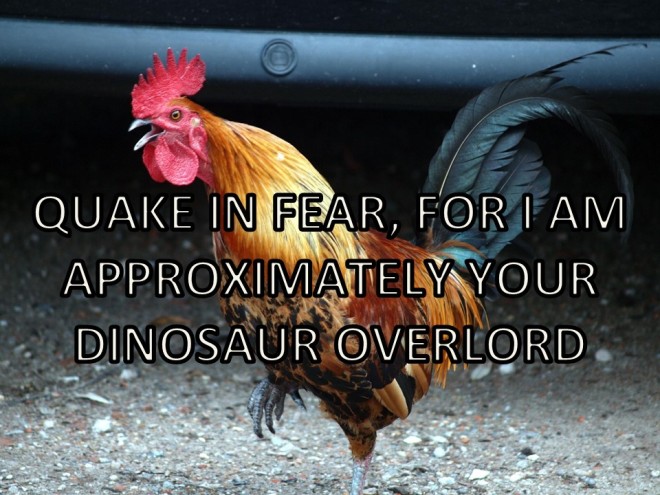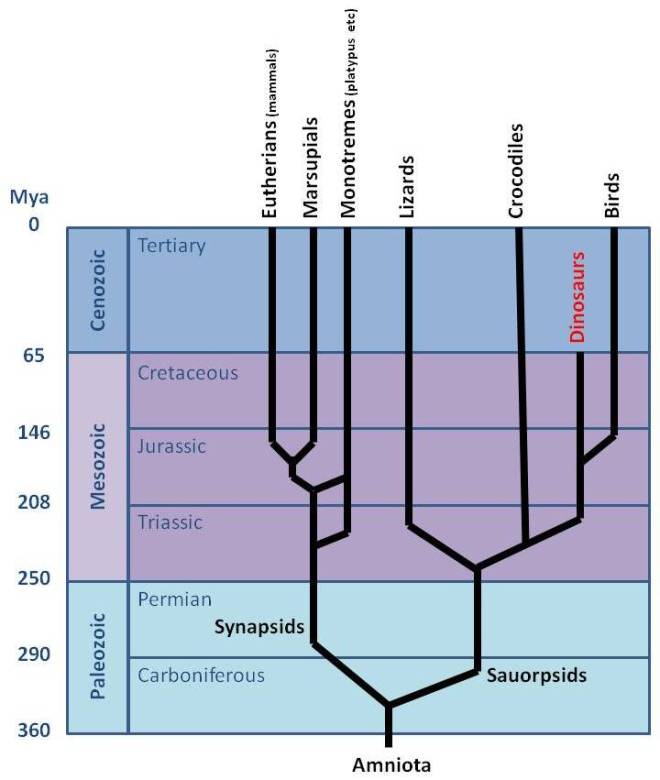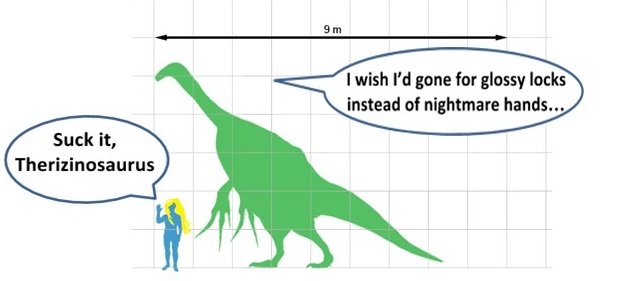Dinosaurs were the most awesome things to ever stomp the earth. I bet every one of us has wished at least once to have seen an Apatosaurus or T-Rex in the flesh, that’s why Jurassic Park is still constantly on TV 22 years after its release. Last year, scientists activated some ancient dinosaur genes lying dormant in their most disappointing descendent – the chicken – causing them to take on some dinosaur-like attributes. Humans are not descendants of dinosaurs, but we do share some common ancestors. How much DNA could the square and lowly Homo sapiens have in common with the rockstars of terrestrial life?
Evolution is a thrifty beast. The creation of a new species is very rarely about the development of new genes and far more commonly about inactivating or repurposing existing ones. The number of genes that are the shared between distantly related species like humans and birds is remarkably high, where both copies originate from a common ancestor. For many basic gene functions, this makes sense: mitochondria, cell membranes and even whole organs function in very much the same way in most animals. There is very little need to change the basic units – the ‘housekeeping genes’ that control the nuts and bolts of life. The genes that do change are the ones that cause subtle adaptions conferring better ‘fitness’ to a particular environment. These small changes are built upon and diversified in tiny steps over time, until the effects of genes in new species are wildly different to what they were in their ancient ancestors.
Birds are direct descendants of raptor dinosaurs. Comparing raptor dinosaurs to the ferocious 3m tall ancient Phorusrhacidae or ‘Terror Bird’ removes any doubt of this. Sadly, nature is cruel. The genes that once served to make velociraptors, utahraptors and deinonychus have now been modified, mangled, repurposed and relegated into making chickens and pigeons. As I mentioned, last year a group of scientists decided that this wasn’t acceptable. They fiddled with gene expression in chicken embryos, and managed to reactivate some of the dormant dinosaur traits still hiding in their DNA. The embryo they created had dinosaur-like curved teeth and a long tail (bird embryos do grow a dinosaur tail during development normally, but it is eliminated long before the chicks hatch). They also noted that chicken wings also share the same bone structure as therapod dinosaur forearms, but made no inferences about their shared deliciousness with hot sauce.  Leaked information from the forthcoming Jurassic World film include hilarious concept art for human-dinosaur hybrids. The pictures are a terrible, but are there any genes that humans do share with dinosaurs, waiting in our genomes to be awakened?
Leaked information from the forthcoming Jurassic World film include hilarious concept art for human-dinosaur hybrids. The pictures are a terrible, but are there any genes that humans do share with dinosaurs, waiting in our genomes to be awakened?
Mammals, marsupials and monotremes are all descended from the synapsid lineage, while dinosaurs, birds and reptiles are of the sauropsid lineage. These two lineages split from their ancestral group Amniota around 350 million years ago. If we share any DNA with dinosaurs, it will be the pieces that both groups of species retained from our common Amniota ancestor.

Adapted from Figure 1 in: “Reconstruction of ancestral brains: Exploring the evolutionary process of encephalization in amniotes”, Nomura, Murakami, Gotoh, Ono, Neuroscience Research v86 pp25-36 (2014)
Early Amniota were probably amphibious, but their defining feature was that they laid complex eggs with calcified shells, which meant they could be laid on land. This is what allowed their descendants to move out of water and colonise the land, eventually splitting into the synapsids and sauropsids. Now that we have public access genome databases for species from both these groups (zebra finch, anoiles lizard; human, mouse), we can identify genes that they share. Although some of these similarities could be the result of convergent evolution (where the same trait evolves independently in different species who face similar selective pressures) this is a rare occurrence, so the majority of shared or similar genes must originate from our common ancestor. If humans and birds inherited these genes from the same place, then it’s a good bet dinosaurs would have had them too. As we are yet to salvage workable DNA from dinosaur remains, the rest of this post will be supposition around this theme.
Non-coding DNA
Some pieces of the genome are tightly conserved between species. This means that there are very few changes to the sequence of DNA bases. Over the hundreds of thousands of years that humans and mice have been distinct species, one would expect the build up of mutations to make our DNA very different, but this is not the case. That makes sense inside genes, which mostly retain common functions, but surely mutations should just randomly accumulate in the bits that don’t code for anything? Not so. Some of these non-coding regions are conserved even more tightly between humans and mice than genes themselves. Recently, a comparison of these shared non-coding regions to the sauropsid genomes found a subset that was also tightly conserved in those species. Of all the regions looked at, 338 regions of at least 500 continuous bases of sequences that code for nothing in humans and mice were identical in the sauropsids, and a further 238 were highly similar. Therefore we probably share these regions with dinosaurs too. What do they do?
Non-coding DNA can be very important to the genome. Remember that each DNA base in a sequence is its own molecule with a specific shape and electrical charge. The sequence of bases, therefore, can impact the 3D structure of the larger DNA molecule. This can be vitally important for maintaining the structural integrity of the molecule, as well as allowing transcription factors (which start the process of actually making the protein a gene provides the code for) access to the correct genes.
Although we know that these regions have no phentypic function in the well-studied genomes of humans and mice, we know less about the more recently sequenced sauropsid genomes. It is possible that some of these regions are coding in these organisms, but they haven’t been formally identified as genes yet. Some of the shared regions do show up in a database of non-coding regions of the zebra finch genome that are known as ‘song transcripts’ because they become ‘active’ (i.e. the DNA changes conformation so external factors can bind to it) in the bird’s brain cells in response to certain songs. Did dinosaurs have song transcripts? If so, I’d love to see what epigenetic response would hearing this evoke…
Genes
Some basic genes are shared between many animals. The gene to make the ‘alpha subunit’ of haemoglobin, for example, is flanked by the same array of genes in humans as it is in birds and lizards. This tells us that either these genes happened to evolve separately and then fall into the same grouping by chance in all these species (unlikely), or that they all evolved before our two lineages diverged and have kept their original layout for the millennia since. Our lineages also share many other common traits that define us as ‘amniota’: tough skin, pulmonary respiration and complete ribcages are just some of these. Many genes encoding for basic features like these in us would likely have done the same thing in dinosaurs.
Some genes that are present in both groups ended up having different functions. One particularly interesting example of this is the gene that manufactures keratin. In mammals, keratin makes hair, nails and hooves and rhinos’ horns (think your matted hair is bad? At least it hasn’t hardened into a mass capable of ramming through steel!). The same gene has been found in lizards, where it is responsible for claw growth. The development of hair was one of the most significant moments in synapsid evolution, allowing us to conserve heat and regulate our body temperature easily. It is likely that hair was one of the key measures of fitness that allowed synapsids to inherit the world from the dinosaurs in the period of global cooling that coincided with their extinction. And yet, all the while the dinosaurs must have possessed the very same gene that conferred this advantage to us – if only they had chosen to use it for beautiful glossy locks instead of giant scary claws they might still be here!  Ancient brains
Ancient brains
The animals we feel the biggest connections with are those who ‘think like us’. Humans tend to find companionship in other mammals because we can empathise with them. What were the brains of dinosaurs like? Would they have shown any sense of what humans consider to be intelligence? Some bird species are undoubtedly smart – African Grey Parrots can learn human words and even piece together sentences, while members of the corvid family have been shown to have Theory of Mind (the ability to think from the perspective of another individual). Has bird intelligence evolved independently, or is it derived from something earlier…common to mammals and dinosaurs?
It is very hard to make any inferences about dinosaur brain structure, as the process of fossilization is not kind to squidgy organs. Although some soft tissue including intact cells from a t-rex was recently unearthed, we have yet to recover any part of a dinosaur’s brain. While the layout and size of an animals’ brain is, of course, determined genetically, it is very poorly understood and a nightmare to compare between species we even have DNA for. Thus for the sake of everyone’s sanity and not taking 300 years to research this blog post, I’m going to look at this from a ‘top down’ approach. Without a dinosaur’s brain or DNA we can study their brains via ‘endocast analysis’: scan the cranial cavity of fossilised remains and create a 3D model or ‘endocast’ of the brain that might fit there. From the size and shape of the endocast, we can make extremely rudimentary inferences about the brain’s structure and organisation. In general, brain size scales up with body size. An ‘encephalization quotient’ (EQ) can be calculated to identify brain regions that exceed their expected size relative to body size in different species. Humans have the largest EQ of any species. In general, the highest EQs are seen in mammals, then birds and then reptiles. Omnivores and carnivores tend to have large brains than herbivores (because herbivores have less energy to expend on smarts, and they don’t need to be smart to eat grass anyway).
Endocast analysis of the ancient mammal Cynodontia* analysed with this method show they had far smaller brains for their body size than modern mammals (an ‘EQ’ of around 0.2: 80% smaller than expected). Endocasts made of dinosaur brains have so far shown that most of them had very low EQs. Triceratops have an EQ of 0.11 and Stegosaurus 0.12. (but as almost indestructible grazing animals, that isn’t so surprising) carnivores fare slightly better, but only had to be smart enough to hunt the herbivores. T. Rex has an EQ similar to that of modern alligators, and some raptors (Troodon, Bambiraptor, and Ornithomimus) just about make it into the remit of modern birds. Winged dinosaurs (Pterosaurs) had particularly high EQs compared to their terrestrial peers with a larger forebrain and cerebellum, which seems to indicate that flight is a key reason why bird EQs are so much higher than reptiles.
*side note: artists impressions of Cynodontia show it is definitely the common ancestor of all bad taxidermy
Dinosaurs brains have the same general layout as birds. Hardly any features of brain layout appear to be common between mammals, birds and reptiles and all EQ estimates for our last common ancestor (a yet-to-be-identified amniote) put its intelligence on par with that of a chocolate tea cake. Sadly, it seems that bird intelligence is in fact an example of convergent evolution, and the fact that both we and birds can be smart doesn’t mean that the way we think is in any way alike, or that dinosaurs had anything we could really call intelligence. So, in conclusion, on a genetic level we may have more similarities with dinosaurs than you might think. Maybe if some of the big impressive ones had survived the cretaceous they would have evolved enough intelligence to carry messages for us, or vocalise that they would like a cracker before horrifically disembowelling and taking the whole packet. While we probably wouldn’t be bosom buddies in a Jurassic Park scenario, we can all rest easier knowing that Velociraptors probably couldn’t figure out how to open doors…and also that the hilarious raptor-human hybrids that were actually considered for Jurassic Park 4 would absolutely definitely have been terrible.
Further reading:
http://ac.els-cdn.com/S0168010214000418/1-s2.0-S0168010214000418-main.pdf?_tid=98b9bbb0-b8f7-11e4-9340-00000aacb35f&acdnat=1424433608_89eae4c94961988f3e313fb6c6a510c0 http://www.nature.com/nature/journal/v464/n7289/full/nature08819.html
http://www.pnas.org/content/106/27/11364.short http://www.sciencedirect.com/science/article/pii/S0262407911619921 http://journal.frontiersin.org/article/10.3389/fnhum.2011.00108/full


great post – tho my attention did lag a little – a propos of nothing in particular –
I sometimes breed chickens and was amazed to find out some time ago that they have almost – perhaps you can clarify? – more genes than any other species ….. which is why you can cross breed them and come up with loads of different variations –
and – I think I’m right here – that unless you endlessly allow the offspring of related hens and cockrels to interbreed, there is enough variation within their genes, not to allow them to develop the kinds of weaknesses that are prominent in over bred dogs etc!
Hi Julz thanks for reading and for the feedback! I didn’t know any of that stuff about chicken breeding that’s so interesting…apparently chickens and humans have a similar number of genes, although their genome is far more ‘streamlined’ in that it contains less junk DNA. I don’t know how this would help with inbreeding, except that in humans large mutations that affect lots of genes tend to be linked to the ‘junk’…maybe these events are rarer in chickens? I’ll have to look it up!
interesting post! and thank you so much for the feedback! (for some reason wordpress wouldn’t let reply to your comment on the thread) I have been making my images 100% so maybe that’s causing it? It looks fine on my computer but i’m wondering if that’s the culprit. Thank you for bringing it to my attention! Let me know how the pancakes turn out! 🙂
Pingback: Mysteries at my feet
Interesting topic which relate’s chicken (bird) Human’s an Dinosaurs waiting for more Great job